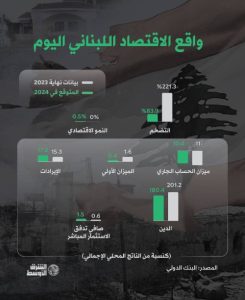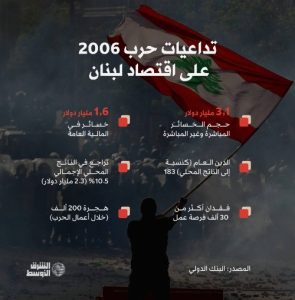شهد لبنان عبر تاريخه الحديث عديداً من الحروب المدمِّرة التي تركت آثاراً كارثية على اقتصاده واستقراره الاجتماعي، أبرزها حرب يوليو (تموز) 2006، حين اندلعت حرب شاملة بين إسرائيل و«حزب الله»، ويتجدَّد المشهد اليوم بين إسرائيل و«حزب الله»، لكن بقواعد مختلفة جداً على صعيد المؤسسات والاقتصاد.
ففي أيام الحرب الـ33، عام 2006، كان لدى لبنان رئيس للجمهورية وحكومة فاعلة، وكان اقتصاده واعداً بنمو متوقع يتراوح بين 4 في المائة و5 في المائة، معزّزاً بتدفق استثمارات مرتفع ساعَد على تحقيق ميزان المدفوعات فائضاً مالياً، وبسيولة عالية لدى القطاع المصرفي الذي كان في ذلك الوقت يلعب دوراً أساسياً في الثقة باقتصاد لبنان، وفي الوقت نفسه، كانت السوق المالية في لبنان تتمتع بزخم إيجابي بسبب ارتفاع الاستثمارات الخليجية التي استفادت من ارتفاع أسعار النفط.

وأثناء حرب يوليو، هبّت الدول العربية، والخليجية خصوصاً، لمساعدة لبنان؛ إذ بلغ مجموع الأموال التي تسلّمَتها الحكومة في ذلك العام من الدول الشقيقة والصديقة والمؤسسات الدولية ما قيمته 1.174 مليار دولار.
كما حظي لبنان في تلك الفترة بدعم دولي، ومساعدات مالية عربية، ما ساعده على الصمود إلى حد كبير في وجه التحديات التي أفرزتها الحرب، حيث تمكّن مصرف لبنان المركزي من التدخل لحماية الليرة، والحفاظ على سعر صرفها، فقد تلقّى مصرف لبنان بعد وقت قصير من اندلاع الحرب وديعة بقيمة 1.5 مليار دولار من الكويت والسعودية، كما تم عقد مؤتمرات دعم دولية لمساعدة لبنان، حيث نجح مؤتمر المانحين في ستوكهولم أغسطس (آب) 2006، وباريس 3 يناير (كانون الثاني) 2007، في توليد دعم كبير من المجتمع الدولي، الأمر الذي خفّف العبء على المالية العامة في لبنان. وخصّص مؤتمر باريس 3 للبنان مِنَحاً وقروضاً ميسّرة بلغت قيمتها 7.6 مليار دولار، بهدف تحفيز القطاع الخاص على النهوض بعد الحرب، وتنفيذ خطة الإصلاح الاقتصادي التي وضعتها الحكومة اللبنانية.
أما اليوم، فيواجه لبنان تحديات اقتصادية غير مسبوقة مع دخوله حرب 2024، حيث تعاني البلاد من أزمة مالية خانقة. فالليرة اللبنانية انهارت، مما أدّى إلى فقدان أكثر من 90 في المائة من قدرتها الشرائية، بينما ارتفعت معدلات التضخم بشكل حادّ، والأهم أن لبنان بات يفتقر إلى الدعم المالي الدولي والعربي، وتراجعت احتياطيات مصرف لبنان بشكل ملحوظ، وتجاوزت خسائر القطاع المصرفي 70 مليار دولار، وانخفض الناتج المحلي بنسبة 50 في المائة، ليجد 80 في المائة من سكان لبنان أنفسهم تحت خط الفقر.

هذا التباين الكبير بين حربَي 2006 و2024 يعكس الفارق الهائل في قدرة لبنان على الصمود، حيث يبدو في موقف أضعف بكثير أمام هذه التحديات المالية والاقتصادية.
هشاشة الوضع الحالي وتغيُّر الظروف
تشير تقديرات البنك الدولي إلى أن الحرب في لبنان عام 2006 كلّفت البلاد خسارة تقدَّر بـ10.5 في المائة من الناتج المحلي الإجمالي، مع أضرار مباشرة وغير مباشرة بلغت 3.1 مليار دولار. واليوم، يبدو لبنان في وضع أكثر هشاشةً، وعلى عكس حرب 2006، يُحتمل أن تفتقر البلاد إلى التمويل من الموارد المحلية، أو من دول الخليج، كما أن استعادة البنية التحتية المتضررة ستتطلّب وقتاً طويلاً، خصوصاً مع التحديات الجسيمة في إدارة آثار أي تصعيد في الصراع، فضلاً عن تلاشي مقوّمات الصمود المعيشية للبنانيين، مما يزيد من حدة التداعيات.
وخلال حرب يوليو 2006 تدخّل مصرف لبنان لضخّ نحو مليار دولار في الأيام الأولى؛ لتهدئة الطلب على الدولار، والحفاظ على استقرار سعر الصرف عند 1500 ليرة، وكان احتياطه من العملات الأجنبية 11.7 مليار دولار. واليوم، تراجَع هذا الاحتياطي إلى 7.5 مليار دولار، معظمها توظيفات إلزامية لأموال المُودِعين، وفي عام 2006 تلقّت الحكومة اللبنانية مساعدات مالية بلغت 1.174 مليار دولار من الدول الشقيقة والصديقة، حيث قدّمت السعودية 734 مليون دولار على شكل هبات نقدية، وساهمت الكويت بـ315 مليون دولار، وسلطنة عمان بـ50 مليون دولار، والعراق بـ35 مليون دولار.
كما أن المقارنة بين حربي 2006 و2024 تُظهر تبايناً كبيراً في الظروف السياسية المحيطة بهما، ففي حرب 2006 كان لبنان تحت قيادة رئيس جمهورية وحكومة فاعلة تعمل على إنهاء النزاع، وتوفير الدعم المالي لإعادة الإعمار، مما أسهم في تحقيق استقرار نسبي بعد انتهاء العمليات العسكرية، أما في حرب 2024 فيعاني لبنان فراغاً رئاسياً ومؤسساتياً، وحكومة تصريف أعمال ذات صلاحيات محدودة، مما يُضعف قدرته على التعامل بفاعلية مع تداعيات الحرب، أو الحصول على الدعم الدولي الضروري.
لبنان تحت وطأة الحرب… وأرقام مقلقة
منذ بداية الحرب في 7 أكتوبر، سادت حالة من الخوف في القطاعات السياحية والخدماتية التي كانت تستعد لاستقبال المغتربين، وتراجعت حركة الوصول في المطار 33 في المائة، وارتفعت مغادرة المسافرين 28 في المائة، ووفقاً للمنظمة الدولية للهجرة، نزح حوالي 29 ألف شخص من الجنوب اللبناني.
ومع دخول الحرب شهرها الثاني، توقعت وكالة «ستاندر آند بورز غلوبال»، أن يؤدي انخفاض السياحة إلى خسارة تصل إلى 23 في المائة من الناتج المحلي الإجمالي، كما توقع البنك الدولي عودة الاقتصاد اللبناني إلى الركود، بعدما كان متوقعاً له نمو طفيف 0.2 في المائة هذا العام.
وفي ديسمبر (كانون الأول)، حذّر برنامج الأمم المتحدة الإنمائي من أن لبنان قد يخسر ما بين 2 و4 في المائة من ناتجه المحلي الإجمالي نتيجة للحرب، وتأثر اقتصاد القطاع الخاص سلباً، حيث انخفض مؤشر مديري المشتريات إلى 49.1، وشهد أكتوبر (تشرين الأول) 2023 انخفاضاً بنسبة 60 في المائة بمعاملات العقارات مقارنةً بالعام الماضي.
وفي يونيو (حزيران)، رفعت شركة الأبحاث «بي إم آي» التابعة لوكالة «فيتش»، توقعات انكماش اقتصاد لبنان إلى حوالي 1.5 في المائة، مع تراجُع ملحوظ في عائدات السياحة مقارنةً بحرب 2006، حيث تكبّد خسائر فادحة تقدَّر بحوالي 3 مليارات دولار، في حين تشير تقديرات نقابات السياحة وأصحاب الفنادق والمطاعم إلى تراجع عائدات القطاع بنسبة 50 في المائة مقارنةً بالعام الماضي الذي حقّق فيه 6 مليارات دولار.
وحسب صندوق النقد العربي، فإن كل زيادة بنسبة 1 في المائة بالإيرادات السياحية تُسهم في زيادة الناتج المحلي الإجمالي بنسبة 0.36 في المائة، وهذا يعني أن لبنان الذي لا يتجاوز ناتجه المحلي الإجمالي حالياً 20 مليار دولار، يفقد فرصة هامة لتعزيز اقتصاده.
وتشير أحدث بيانات أغسطس (آب) إلى أن الحرب منعت المزارعين من زراعة 17 مليون متر مربع من الأراضي الزراعية. ومن المتوقع كذلك أن يشهد القطاع الصناعي تراجعاً يتجاوز 50 في المائة، مما يعادل خسائر تُقدَّر بحوالي مليارَي دولار. كما أن تعطُّل الموانئ سيفاقم الأزمة المعيشية، مما سيؤدي إلى خسائر إضافية تُقدَّر بـ 1.5 مليار دولار.
18 عاماً على حرب يوليو 2006
أدّت الحرب إلى خسائر اقتصادية تقدّر بحوالي 7 مليارات دولار، منها 3.6 مليار دولار نتيجة تدمير البنية التحتية، و1.6 مليار دولار خسائر في المالية العامة، و2.4 مليار دولار طالت الناتج المحلي.
وقبل الحرب، حقّقت الحكومة اللبنانية فائضاً أولياً بلغ 660 مليون دولار في النصف الأول من عام 2006، لكن الحرب أضعفت الاستقرار المالي، كما تأثرت الاستثمارات الأجنبية التي حققت أرباحاً بقيمة 4.8 مليار دولار، سلباً، مما غيّرت من شهية المستثمرين.
وعلى الرغم من القروض ذات الفوائد المنخفضة لإعادة الإعمار، فقد ارتفعت قيمة الدَّين العام إلى 41 مليار دولار، ما يمثل 183 في المائة من الناتج المحلي الإجمالي، مع تراجع النمو إلى 1.6 في المائة، وتكاليف خدمة الدين بنسبة 3.02 في المائة بنهاية 2006.
شلل اقتصادي شامل
وبرغم غياب إحصائيات دقيقة عن الخسائر الفادحة الناجمة عن الصراع المستعِر، فإن المؤكد أن التكلفة الحقيقية تتجاوز التقديرات بكثير، فالشلل التام الذي أصاب القطاعات الاقتصادية الأساسية يهدّد بانهيار البنية التحتية، ويدفع بالاقتصاد إلى الهاوية، وتشير التقديرات الأولية إلى أن الخسائر تجاوزت بالفعل 10 مليارات دولار، وهو رقم يفوق نصف إجمالي الناتج المحلي، مما يعكس عمق هذه الحرب وخطورتها.
المصدر: هدى علاء الدين – الشرق الأوسط
Lebanon's Economy in the War Crisis: From International Support in 2006 to Financial Void in 2024
Throughout its modern history, Lebanon has endured numerous devastating wars that have left catastrophic impacts on its economy and social stability. A notable example is the July 2006 war, which erupted into a full-scale conflict between Israel and Hezbollah. Today, the situation is once again tense between Israel and Hezbollah, but the rules governing institutions and the economy have changed dramatically.
During the 33-day war in 2006, Lebanon had a sitting president and an active government. The economy was on a promising growth trajectory, expected to expand between 4% and 5%, bolstered by significant investment inflows that resulted in a financial surplus in the balance of payments. The banking sector was liquid and played a crucial role in instilling confidence in Lebanon's economy. At the same time, the financial market was buoyed by increased Gulf investments, benefiting from soaring oil prices.
During the July war, Arab nations, particularly Gulf states, rushed to aid Lebanon, providing the government with a total of $1.174 billion from friendly countries and international institutions. Additionally, Lebanon received international support and financial assistance from Arab nations, which helped it withstand the challenges brought on by the war. The Central Bank of Lebanon intervened to protect the Lebanese pound and maintain its exchange rate. Shortly after the war broke out, the Central Bank received a $1.5 billion deposit from Kuwait and Saudi Arabia. Moreover, international donor conferences, such as the Stockholm Conference in August 2006 and Paris III in January 2007, generated substantial international support, easing the burden on Lebanon's public finances. The Paris III conference allocated $7.6 billion in grants and concessional loans to stimulate the private sector's recovery post-war and to implement the economic reform plan devised by the Lebanese government.
Today, Lebanon is grappling with unprecedented economic challenges as it enters the 2024 war. The country is experiencing a crippling financial crisis, with the Lebanese pound having collapsed and losing more than 90% of its purchasing power. Inflation rates have surged sharply, and critically, Lebanon lacks international and Arab financial support. The Central Bank's reserves have significantly dwindled, losses in the banking sector exceed $70 billion, and the GDP has plummeted by 50%, leaving 80% of the Lebanese population below the poverty line.
The stark contrast between the wars of 2006 and 2024 highlights Lebanon's diminished resilience. It appears significantly weaker in facing these financial and economic challenges.
Fragility of the Current Situation and Changing Conditions
According to World Bank estimates, the 2006 war cost Lebanon an estimated 10.5% of its GDP, with direct and indirect damages amounting to $3.1 billion. Today, Lebanon is in a more precarious position. Unlike in 2006, the country may lack financing from local resources or Gulf states, and restoring damaged infrastructure will take a considerable amount of time, especially given the severe challenges in managing the impacts of any escalation in conflict. Furthermore, the living resilience factors for the Lebanese people have eroded, exacerbating the consequences.
During the July 2006 war, the Central Bank intervened by injecting approximately $1 billion in the early days to calm demand for dollars and stabilize the exchange rate at 1,500 pounds. Its foreign currency reserves stood at $11.7 billion. Today, those reserves have declined to $7.5 billion, mostly tied up in mandatory deposits from depositors. In 2006, the Lebanese government received $1.174 billion in financial assistance from friendly nations, with Saudi Arabia contributing $734 million in cash grants, Kuwait $315 million, Oman $50 million, and Iraq $35 million.
The comparison between the wars of 2006 and 2024 shows significant disparities in the surrounding political conditions. In 2006, Lebanon was led by a president and an effective government working to resolve the conflict and secure financial support for reconstruction, contributing to relative stability after the military operations ceased. In contrast, the 2024 war sees Lebanon facing a presidential and institutional vacuum, with a caretaker government that possesses limited powers, undermining its ability to effectively address the war's consequences or secure necessary international support.
Lebanon Under the Weight of War… Alarming Numbers
Since the war began on October 7, fear has permeated the tourism and service sectors, which were preparing to welcome expatriates. Airport arrivals plummeted by 33%, while departures rose by 28%. According to the International Organization for Migration, approximately 29,000 people have been displaced from southern Lebanon.
As the war entered its second month, S&P Global Ratings predicted that the decline in tourism could result in a loss of up to 23% of GDP. The World Bank anticipated that the Lebanese economy would return to recession, having previously been expected to experience slight growth of 0.2% this year.
In December, the United Nations Development Programme warned that Lebanon could lose between 2% and 4% of its GDP due to the war, negatively impacting the private sector economy. The Purchasing Managers' Index dropped to 49.1, with a 60% decrease in real estate transactions compared to the previous year noted in October 2023.
In June, Fitch's BMI Research revised its forecast for Lebanon's economic contraction to about 1.5%, with a noticeable decline in tourism revenues compared to the 2006 war. Losses were estimated at around $3 billion, while tourism and hospitality unions projected a 50% decrease in sector revenues compared to last year's total of $6 billion.
According to the Arab Monetary Fund, a 1% increase in tourism revenues contributes to a 0.36% increase in GDP. This means that Lebanon, with a GDP currently around $20 billion, is losing significant opportunities to bolster its economy.
Recent data from August indicates that the war has prevented farmers from cultivating 17 million square meters of agricultural land. The industrial sector is also expected to see a decline exceeding 50%, equivalent to losses estimated at around $2 billion. Furthermore, port closures will exacerbate the humanitarian crisis, leading to additional losses estimated at $1.5 billion.
18 Years Since the July 2006 War
The war led to economic losses estimated at around $7 billion, including $3.6 billion due to infrastructure destruction, $1.6 billion in public finance losses, and $2.4 billion affecting the GDP.
Prior to the war, the Lebanese government recorded a primary surplus of $660 million in the first half of 2006. However, the war weakened financial stability, negatively impacting foreign investments that had previously generated $4.8 billion in profits, thus changing investor sentiment.
Despite low-interest loans for reconstruction, the public debt rose to $41 billion, representing 183% of GDP, with growth falling to 1.6% and debt service costs at 3.02% by the end of 2006.
Comprehensive Economic Paralysis
While there are no accurate statistics on the severe losses resulting from the ongoing conflict, it is certain that the actual cost far exceeds estimates. The complete paralysis of essential economic sectors threatens infrastructure collapse and pushes the economy towards the brink of disaster. Preliminary estimates indicate that losses have already surpassed $10 billion, a figure exceeding half of total GDP, reflecting the profound depth and danger of this war.
translated by economyscopes team
 سكوبات عالمية إقتصادية – EconomyScopes إجعل موقعنا خيارك ومصدرك الأنسب للأخبار الإقتصادية المحلية والعربية والعالمية على أنواعها بالإضافة الى نشر مجموعة لا بأس بها من فرص العمل في لبنان والشرق الأوسط والعالم
سكوبات عالمية إقتصادية – EconomyScopes إجعل موقعنا خيارك ومصدرك الأنسب للأخبار الإقتصادية المحلية والعربية والعالمية على أنواعها بالإضافة الى نشر مجموعة لا بأس بها من فرص العمل في لبنان والشرق الأوسط والعالم




